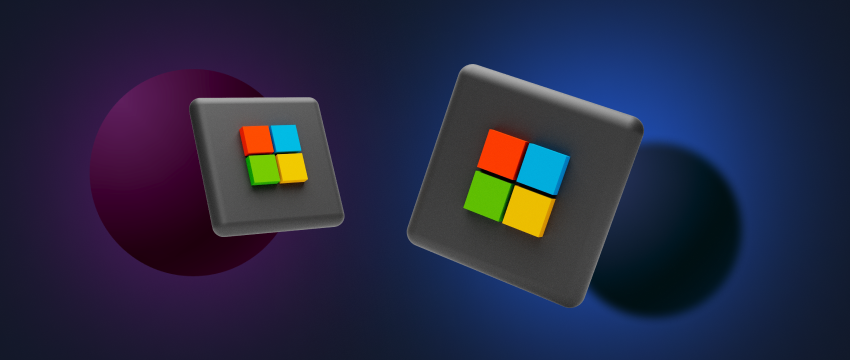Microsoft Corporation is a leading American multinational technology company. The company’s headquarters are in Redmond, Washington. Its best-known products are the Windows operating system, the Microsoft 365 productivity suite, Azure cloud platform, and Edge web browser. Popular hardware products are the Xbox gaming consoles and the Microsoft Surface lineup of touchscreen PCs. Microsoft Stock is widely followed by investors, reflecting the company’s strong market presence.
In 2022, Microsoft ranked No. 14 in the Fortune 500 rankings of the largest U.S. companies by revenue. Forbes named it the top software company globally by revenue. Microsoft is one of the “Big Five” American tech giants, alongside Alphabet (parent company of Google), Amazon, Apple, and Meta (parent company of Facebook)
The growth of Microsoft: From 1975 to industry leader
Microsoft was founded in 1975 by Bill Gates and Paul Allen. They developed and sold BASIC interpreters for the Altair 8800. By the mid-1980s, the company had dominated the PC market with the introduction of Windows.
Microsoft’s 1986 IPO and the subsequent rise in its stock created three billionaires and around 12,000 millionaires among its employees.
Since the 1990s, Microsoft has expanded beyond operating systems through a series of acquisitions, the biggest being the acquisition of Activision Blizzard for $68.7 billion in 2023, followed by LinkedIn for $26.2 billion in 2016, Nuance Communications for $16 billion in 2022, and Skype for $8.5 billion in 2011.
Since 2015, Microsoft has been a leader in the IBM PC compatible operating system market and the office software suite market. Although it has lost most of the overall operating system market to Android.
The company also offers a wide range of consumer and enterprise software for desktops, laptops, tablets, gadgets, and servers, including Bing (Internet search), MSN (digital services market), HoloLens (mixed reality), Azure (cloud computing), and Visual Studio (software development).

Stock performance
The company has a market cap of $3.16 trillion, a price-to-earnings ratio of 35.09, a PEG ratio of 2.24 and a beta of 0.91. Its 50-day moving average price is $421.71, while the 200-day moving average stands at $425.43. The company maintains a debt-to-equity ratio of 0.15, a quick ratio of 1.29 and a current ratio of 1.30.
On October 30th, Microsoft (NASDAQ:MSFT) released its quarterly earnings report. The company reported earnings per share (EPS) of $3.30 for the quarter, exceeding analysts’ consensus estimates of $3.10 by $0.20. Revenue for the quarter reached $65.59 billion, surpassing analysts’ expectations of $64.57 billion.
The results showed a 16.0% year-over-year increase in revenue, with a net margin of 35.61% and a return on equity of 34.56%. During the same quarter last year, Microsoft reported an EPS of $2.99. Based on current trends, sell-side analysts project the company will achieve an EPS of 12.94 EPS for the current year.
Microsoft increases dividend
Microsoft recently announced an increased quarterly dividend of $0.83, up from its previous quarterly dividend of $0.75. The dividend will be paid on Thursday, December 12th to shareholders of record as of Thursday, November 21st, with an ex-dividend date of the same day. This increase brings the annualised dividend payout to $3.32, offering a dividend yield of 0.78%. The company maintains a dividend payout ratio of 24.75%.
In addition, Microsoft’s board approved a $60 billion stock buyback plan on Monday, September 16th. This authorisation allows the company to buy up to 1.9% of its outstanding stock through open market transactions.

Microsoft’s AI growth faces challenges amid slowing profits
Artificial intelligence (AI) has revolutionised many businesses, allowing tech companies to develop existing products and services, and discover new growth opportunities. Investors have eagerly jumped toward stocks capitalising on these opportunities. Microsoft stands out as a prime example of this.
The company has experienced increased growth in recent quarters driven by the success of its AI-powered products, which have boosted both sales and profits. Today, its market cap is $3.1 trillion, as investments in AI seem to be paying off, at least for now.
However, a closer examination of Microsoft’s recent earnings report reveals a worrying trend. If this pattern continues, it could present challenges for the company’s stock in the near future.
Profit growth is slowing
One of the biggest challenges facing AI-driven companies is the heavy spending required, not just on developing new AI initiatives but also on promoting and marketing them. And the returns aren’t always clear to investors.
In Microsoft’s most recent earnings report, for the period ending September 30, its net income increased by approximately 11%.
There are also concerns that the company’s AI may not be so impressive. Salesforce CEO Marc Benioff recently compared Microsoft’s AI product, Copilot, to its 1990s assistant, Clippy, which became known for being more of a nuisance than helpful.
Moreover, a recent CNBC survey found that nearly half of the companies using Copilot remain uncertain about rolling it out or are still in the testing phase. It hasn’t yet proven to be the game-changing product that investors and analysts had hoped for.

Microsoft’s valuation and growth outlook
Microsoft’s stock is trading at approximately 35 times its trailing earnings, which is lower than the average stock in the Technology Select Sector SPDR Fund which is at a multiple of nearly 42.
While this valuation may appear reasonable, tech stocks have been driven by their strong earnings performance this year. If growth across the sector begins to slow, highly valued stocks like Microsoft could face significant pressure.
Disclaimer: This material is for general informational and educational purposes only and should not be considered investment advice or an investment recommendation. T4Trade is not responsible for any data provided by third parties referenced or hyperlinked in this communication.




